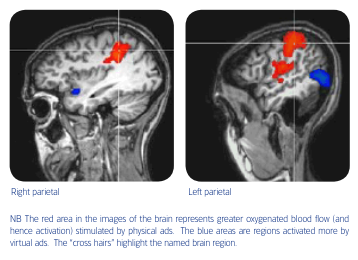It’s no secret that digital marketing is growing rapidly these days. And though it will continue to do so, that doesn’t mean that print is being replaced (or is dead, which people have been claiming at least since “Ghostbusters”). Instead, digital and print marketing have become complements to each other.
A Millward Brown study may suggest why (and how) these two types of marketing can coexist: the need for continued print marketing is rooted at the neurological level of consumers.
Print Marketing Leaves a “Footprint”
The study used fMRI scanning to observe how brain reactions differed when subjects were shown direct mail print ads than when they viewed the same ad on a screen. The results found that “tangible materials leave a deeper footprint on the brain.”
This “footprint” is achieved in two ways:
- More brain responses connected to internal feelings were immediately produced when observing physical materials,
- Print involved more emotional processes than when observing ads on a screen. The study finds the latter part is important for “memory and brand associations.”
In other words, print makes you feel more strongly, which in turn helps you remember.
It’s Not All in Your Head
But how does this neurological-level research translate to how consumers actually act and feel? A separate study finds that consumers trust print ads more than any other source.
The VTT study asked how much trust consumers put in advertising from different mediums; 63 percent trusted ads in magazines and newspapers, while TV and the internet received trust ratings of 41 percent and 25 percent, respectively.
The outlook of the study for print marketing materials was good, as well. Direct mail has more trust than social media, while catalogs are trusted more than the internet.
What Happens Next?
Will these trust percentages change? Probably so.
Trust of digital is on its way up, and as consumers get more familiar with it, they’ll learn what sources to trust and what sources to stay away from – just like they already do for print.
And when this happens, it will be important to remember the most important finding of these studies:
Both digital and printed marketing materials have their own unique place within a marketing strategy.
Realizing this and planning your strategy accordingly is the key to staying ahead of the curve (i.e. out in front of your target audience).
The Advantages & Disadvantages of Digital and Print
For some initial guidance on how to effectively combine digital and print marketing, a report by Qube looks into the pros and cons of both. Unsurprisingly, they echo the findings of the aforementioned neurological study.
Print is best used for three things, according to the study:
1. To build and maintain brand awareness (even if there is a shift to online).
2. For more in-depth or longer pieces
3. When marketers want consumers to focus only on one item (as opposed to the multitasking of consumers when they read online).
Digital, on the other hand, boasts the following advantages:
1. The greatest of the web’s benefits is the opportunity to interact with and listen to customers.
2. It can be utilized as a quick testing ground to garner feedback:
– to broadcast time-sensitive, quick information bites to consumers
– to serve as an effective channel when consumers are looking for immediate information
Obviously, all three studies and reports listed here are fairly specific in their testing and types of research. Therefore it’s more important than ever to use these guidelines as a base for your print marketing materials campaigns and then tailor them to your exact needs (and those of your customers).




